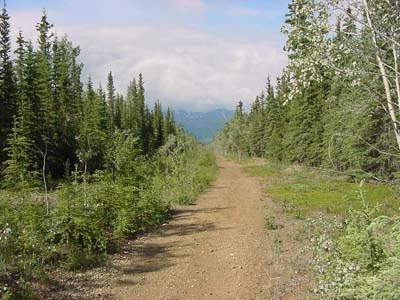
Jennifer Probert has been wondering for several years now why she knows so many people with cancer.
The 28-year-old mother grew up in Tok, Alaska, a small community of 1,500 people, on the Alaska Highway, about 200 miles southeast of Fairbanks. “What really made me curious is that really healthy people were getting sick,” she said. “People that don’t smoke, don’t drink, lead very healthy lives.” She relayed her concerns to her mother and sister and together they made a list of cancer patients and tried to see what they had in common.
The list had over 50 people on it with such cancers as lung, stomach, kidney and bladder. A link emerged. Many had either worked in the operation and maintenance of part of a now disbanded 626-mile military petroleum pipeline that began in Haines, Alaska and ended in Fairbanks, with about half the pipeline in Canada.
Probert, an Athabascan Indian, at first didn’t know what about the pipeline could be the possible cause of the cancer, but now she has a suspect.
She learned of an Army memo confirming that Agent Orange, a herbicide that was used during the Vietnam War to clear out jungle foliage, also was used to strip vegetation from the pipeline’s corridor in the 1960’s. Probert worries about what that could mean. The Haines/ Fairbanks pipeline was a central feature in Tok, employing many residents. Now its abandoned right of way crosses through the yards of Tok homes, she said.
“We use it a lot for four-wheelers,” she said. “My parents planted their lawn and their garden on it. My own house is right on top of it.” Could the herbicide have caused some of the illnesses she’s witnessed in her friends and family? She knows finding a link between its use and the health of her community will be difficult. “(I hope) they find the link, clean it up and from now on out life will be wonderful,” she said.
Both federal and state agencies have begun a search for the herbicide, action spurred by the Army memo. The U.S. Army Corps of Engineers plans to take 20 soil samples from the Alaska side of the former pipeline corridor, about 300 miles of the old pipeline site. They will take five background samples. The Alaska Department of Environmental Conservation insisted they do the sampling.
The history of Agent Orange use in Alaska is sketchy. It is known and documented that the Army used three types of herbicides on land surrounding the eight-inch pipeline that was built in 1953 to supply petroleum products for interior military bases, said Richard Jackson, a Corps project manager based in Anchorage. The pipeline operated until 1971.

One herbicide, called Esteron, was the same herbicide that was used during the Vietnam War. It was called Agent Orange because of an orange stripe on the barrels that contained the product.
The Veterans Administration has linked Agent Orange to prostate cancer, non-Hodgkins lymphoma, lung cancer, bronchus, larynx, trachea, multiple myeloma and soft tissue sarcomas among Vietnam veterans as well as diabetes type II and birth defects in their children.
The reason can be blamed on a dioxin found in Agent Orange that was accidentally formed in a manufacturing glitch of some batches of the herbicide.
That dioxin, known as 2,3,7,8 TCDD, is what the Corps is searching for in the soils of the pipeline’s right of way.
This particular dioxin is extremely toxic, said Greg Light, a military environmental specialist with the Department of Environmental Conservation. That’s why the DEC formally asked the corps to investigate, he said.
“My gut feeling is that the residue is low,” Light said, adding that spraying happened more than 30 years ago.
“If there was harm from this spraying, it was probably already done. We just got to find out whether or not it’s there.” But the Corps has already confirmed that a small amount of the dioxin has been found near Tok on a section of land not related to the Haines pipeline.
The amount was too small to require action other than future evaluation, but that it was found at all has raised concerns and speculation by private citizens and government officials. Was Agent Orange used elsewhere in Alaska? Did it drift over from spraying on the Haines pipeline which is across the road from where the dioxin was found? Was there another source that placed 2,3,7,8 TCDD at the site? Jackson said he will not address that issue until 2005 because now he is focusing on the Haines pipeline.
DEC’s Light says the finding is just another thing to deal with in the hunt for Agent Orange in Alaska. Dioxin, particularly 2,3,7,8 TCDD, is one of the deadliest man-made chemicals known in the world, suspected of causing a host of diseases, said Pam Miller, the executive director of the Alaska Community Action on Toxics, an Anchorage-based military contamination watchdog organization. The World Health Organization has termed TCDD as a carcinogen, and was found at Love Canal in Niagara Falls, New York. “It is extremely persistent at extremely low levels,” she said. Dioxins are also known as an endocrine disrupter, meaning it interferes with the hormonal communication between cells, according to Rachel’s Environment and Health Weekly, reports compiled by Dr. Peter Montague, of the Environmental Research Foundation. The toxic can disrupt growth and sexual maturation, the weekly reports.
What Agent Orange could have done to impact the health of Alaskans is not known. There have been no health findings, good or bad, concerning any population along the pipeline route to date by the Alaska State Department of Health and Social Services. But neither have there been studies. “It’s too early to tell,” said Tracey Lynn, program manager and epidemiologist in the department. “The whole area is clouded with uncertainty,” Lynn said, adding that many factors would have to be considered in determining illness. “There are so many questions marks around it, it is difficult to say what the potential outcomes will be.”
Nor has there been any official finding of deformities among the wildlife that inhabits the area, said Bruce Woods, a public affairs officer with the U.S. Fish and Wildlife Service. “I don’t know of any studies,” he said. “I suspect if something were happening it would have been noticed.” There have been anecdotal stories of moose discovered to have hemorrhaged stomachs, believed to have been caused by eating leaves that were sprayed with the herbicide. One such story was included in report compiled for the Champagne and Aishihik First Nations, both Canadian tribes that live and hunt near the Canadian portion of the pipeline. Recently, the Corps held public meetings in Fairbanks and Tok to solicit information from the public about the pipeline. The Corps needs the input to determine from which areas to take soil samples in their search for the toxin, said Richard Jackson, a Corps project manager.
“We want to get samples before the snow flies,” Jackson said at a Tok public meeting. “We need to hear from people familiar with the area or a stake holder.” The Corps plans to spend $300,000 to get the samples.
There is conflicting science about how long the dioxin remains in soil, said David Westerman, a Corps environmental engineer.
“I’ve heard three and half years to seven years,” Westerman said.
But it is hard to say for sure, especially when considering arctic conditions, he said. Around the Tok area, some of the Alaska’s most frigid temperatures are recorded there, reaching 60 degrees below zero or colder at times. Because the dioxin is so dangerous to human health, the corps has set a detection limit of 3.9 parts per trillion. That would be similar to a solution made up of 4 million gallons of water or enough to fill a large tank and nearly four drops of the dioxin, Westerman said. If the dioxin is found at that level, it would trigger further investigation, including more sampling which could lead to a cleanup plan, he said.
The herbicides were only supposed to be applied within the 50-foot pipeline right of way and not within 500 feet of any stream or water body, Westerman said.
It was either sprayed from the back of trucks or by helicopter, he said.
Spraying was supposed to be called off if the wind blew more than 5 mph, he said. A former manager at a pipeline pump station in Tok recalled that nothing grew in the right of way for about 10 years after the pipeline was shut down and spraying was discontinued.
“Oh, it killed everything,” said John Burnham of Tok. “We didn’t think much of it. It has grown back.” Most of the old pipeline’s route near Tok has grown back with moss, low-lying plants, birch, spruce and alder trees, but sections, such as the heavily-used trails, are still bare. Much of the route from Fairbanks to Haines is still used for recreation and hunting year around.
The sampling falls under a Department of Defense cleanup program called Formerly Used Defense Sites, Jackson said. There are more than 600 such sites in Alaska, he said.
Much of the former pipeline right of way is on state land, while other sections are tribally or privately owned.
“That’s where we picked raspberries,” said Lorraine Titus, president of the Northway Traditional Council, an Athabascan community 50 miles from Tok.
“That’s the only place it grew, not brush, not trees, just raspberries.” Titus said that cancer was rare until the 1960’s in the village of 300 people. The village council has noted about 25 cases of breast, colon, lung and liver cancer since then.
That anecdotal evidence is consistent with reports generated from the Alaska Native Tumor Registry which says cancer was rare for all Alaska natives back in the 1950’s. Now the rate has doubled in the last 30 years and cancer is the number one cause of death among Alaska natives. Registry-based reports blame tobacco for about 30 percent of the deaths, which were from lung cancer. Another 30 percent is from colorectal cancer, which some health professionals blame on low fiber, high fat diets. But some people who live around the former pipeline wonder if the herbicide was the cause of cancers in their families. “I think it would be good for someone to tell us whether it was safe or not,” said Alice Breen, a part-time Tanacross resident and Jennifer Probert’s aunt. Tanacross, an Athabascan community of about 150 people, is ten miles from Tok. Breen’s husband worked at the Tok pump station and survived stomach cancer twice, she said.
Probert says she can’t ignore her concerns about cancer in her community.
“Part of me is scared and leery,” she said. “I don’t know what turning over this rock completely involves. I feel I’m obligated to my family and friends and loved ones. I feel obligated and bound to at least continue and be interested in this.”
©2004 Diana Campbell
Diana Campbell, a reporter for the Fairbanks Daily News-Miner, examined the incidence of cancer in various Alaska communities during her fellowship year.


